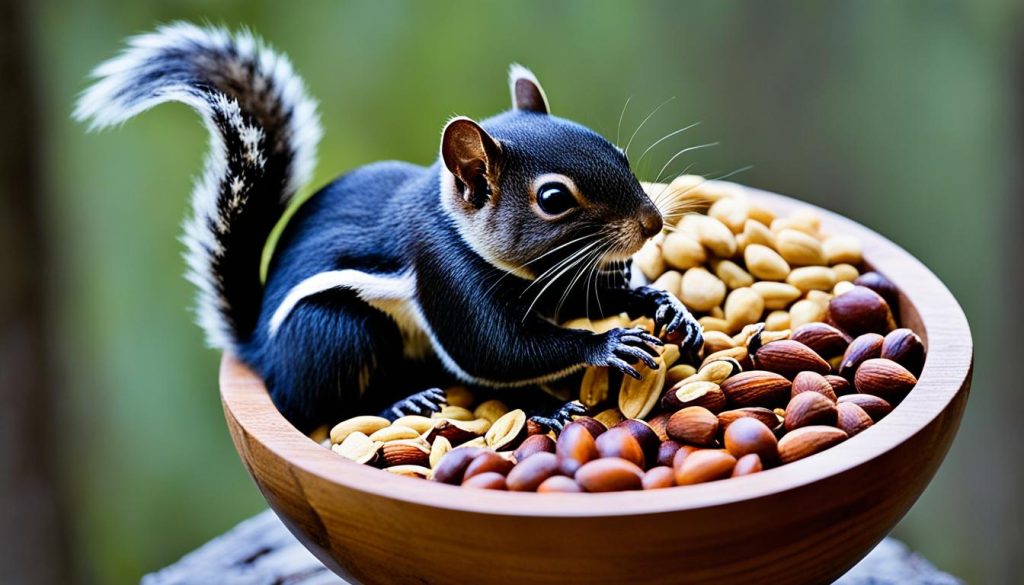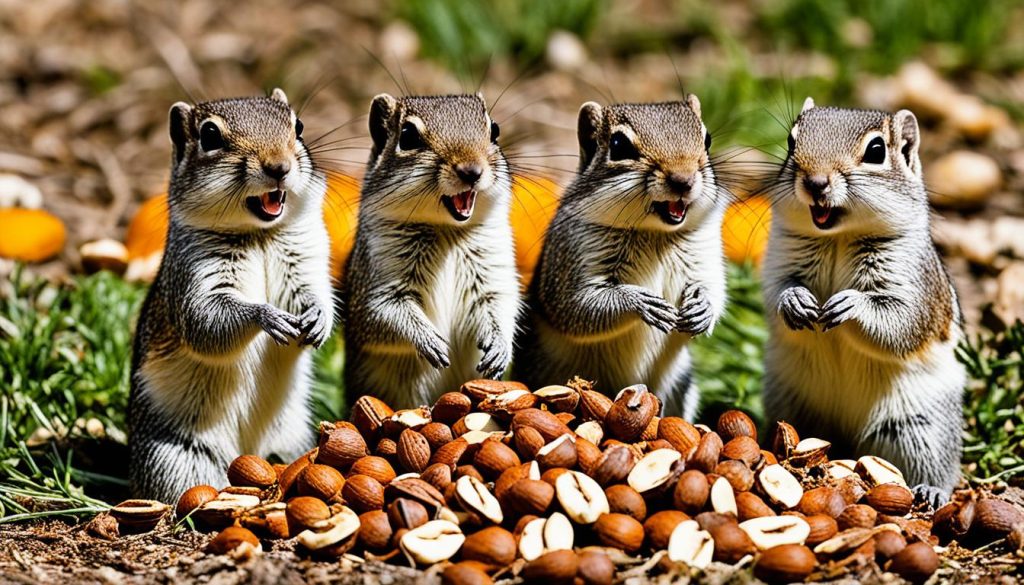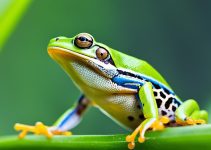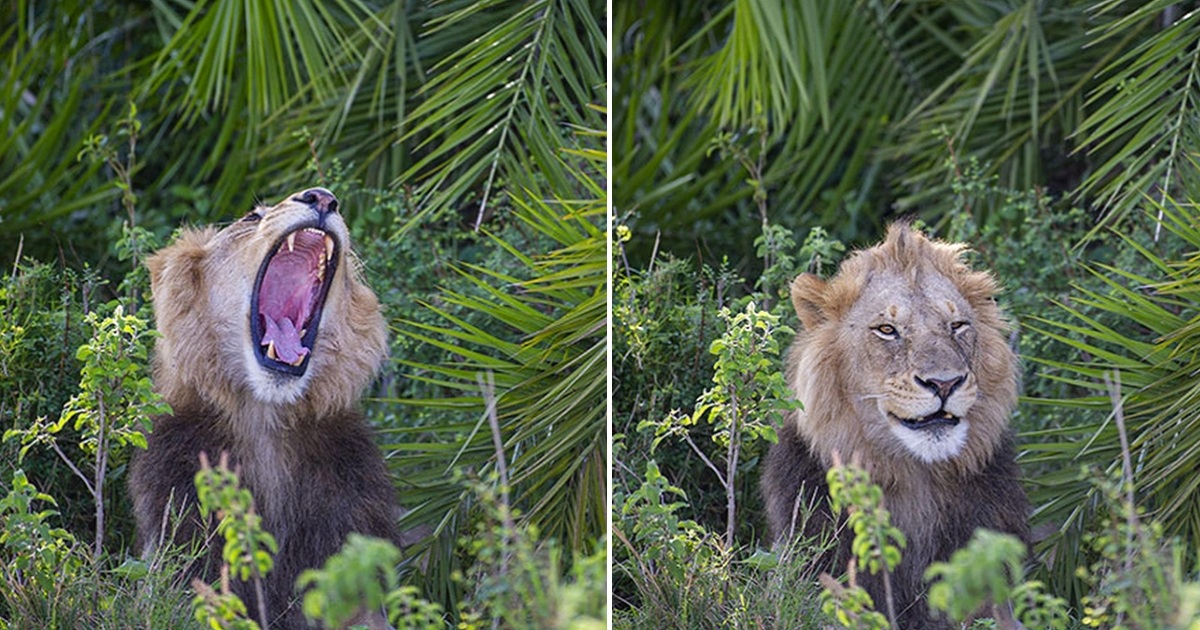Have you ever wondered what squirrels eat? These small, nimble creatures are not just limited to nuts. Squirrels have a varied diet that includes flowers, fruits, seeds, grains, fungi, and even meat from insects and small animals like bird eggs and juvenile snakes.
Squirrels are found worldwide, except in Antarctica and Australia. They are known for their foraging abilities and adaptability, making them fascinating creatures to study. Let’s delve deeper into the squirrel diet and explore their feeding habits, favorite foods, and nutritional needs.
What Do Squirrels Eat?
- Squirrels have an omnivorous diet, including nuts, fruits, seeds, grains, fungi, and insects.
- They are adaptable creatures with a wide range of food preferences.
- Squirrels play an important role in the ecosystem as both prey and predators.
- Understanding squirrel diets helps us appreciate their ecological significance.
- Explore the different types of squirrels to learn more about their specific food choices.
Squirrel Diet by Types
Squirrels, fascinating creatures found all over the world, can be categorized into three main types: tree squirrels, ground squirrels, and flying squirrels. Each type has its own unique dietary preferences and foraging habits.
Tree Squirrels Diet
Tree squirrels, known for their impressive acrobatics and nimble climbing abilities, predominantly feast on nuts and various fruits. Their diet includes delicious walnuts, hazelnuts, acorns, berries, and other delectable tree fruits. These agile creatures are frequently seen scurrying up trees, tirelessly searching for their favorite treats.
Ground Squirrels Diet
Ground squirrels, on the other hand, are primarily seed and nut enthusiasts, but they also have a diverse diet. They rely heavily on seeds and nuts for sustenance, but they also indulge in a variety of other foods such as vegetables and insects. Their diet includes tasty treats like sunflower seeds, almonds, corn, and even insects like grasshoppers and beetles.
Flying Squirrels Diet
Flying squirrels, despite their name, do not have a desire for wings, but they do have a taste for fruits, insects, and nuts. These nocturnal gliders use their unique ability to soar through the night sky to locate their preferred food sources. Their diet consists of berries, fruits from trees, nuts like acorns, and small insects, which serve as a protein-rich addition to their diet.
Now that we have explored the different types of squirrels and their dietary preferences, let’s delve deeper into the specific diets of black flying squirrels, California ground squirrels, and western palm squirrels in the upcoming sections.
What Do Black Flying Squirrels Eat?
Black flying squirrels, scientifically known as Aeromys tephromelas, have a diverse diet that includes a variety of foods. Their primary food sources consist of nuts, shoots, leaves, fruits, seeds, grains, and insects like cicadas. These squirrels have adapted to forage for their food in forests, including both primary and secondary forests, as well as in gardens.
Compared to other squirrel species, black flying squirrels are larger in size. Females are slightly larger than males. They can grow to a length of 25.5 to 42.6 cm and weigh between 1.128 and 1.25 kg. Their larger size enables them to navigate through the forest canopy and glide from tree to tree with ease.
The diet of black flying squirrels plays a crucial role in their survival and ability to thrive in their habitats. By consuming a diverse range of nuts, fruits, seeds, grains, and insects, they maintain a balanced nutrition that supports their energy needs for gliding and other activities.

Habitat and Size of Black Flying Squirrels
Black flying squirrels can be found in various forest environments, including both primary and secondary forests. They are also known to venture into gardens, taking advantage of available food sources. These squirrels have adapted to different types of habitats, allowing them to thrive in diverse ecosystems.
When it comes to size, black flying squirrels are larger than many other squirrel species. The females, in particular, tend to be slightly larger than males. This size difference can be attributed to different evolutionary factors and mating strategies within the species.
Overall, the diet, habitat, and size of black flying squirrels contribute to their adaptability and success in their natural environments. Their feeding preferences and physical characteristics make them fascinating creatures to study and observe in the wild.
What Do California Ground Squirrels Eat?
California ground squirrels, also known as Otospermophius beecheyi, have a varied diet that consists primarily of seeds and nuts. They are known to consume a wide range of seeds and nuts, including acorns, jimson weed, mallow, grass seeds, black walnuts, and tarweed. In addition, they also include fruits and insects in their diet.
These ground squirrels can be found in a variety of habitat types, including open fields, pastures, mountainous rocky outcrops, grasslands, and valleys. They prefer habitats with loose soils that are suitable for burrowing, as they create extensive burrow systems for shelter and protection.
The California ground squirrels typically measure about 14 to 20 inches in length, with males being slightly larger than females. They have a robust and compact body structure, which allows them to efficiently navigate their habitat and forage for food.
Here is a summarized list of the California ground squirrels’ diet:
- Seeds and nuts (acorns, jimson weed, mallow, grass seeds, black walnuts, tarweed)
- Fruits
- Insects
Understanding the dietary preferences and habitat requirements of the California ground squirrels is crucial for their conservation and management, as well as for maintaining the balance of ecosystems they inhabit.

What Do Western Palm Squirrels Eat?
Western palm squirrels, or Epixerus ebii, have a varied diet consisting of seeds, fruits, nuts, grains, and occasionally insects. These adorable creatures are native to the western region of Africa, specifically in countries like Gabon, Congo, Sierra Leone, and Equatorial Guinea. They can be found in the undergrowth of thick forests, where they thrive in their natural habitat. Western palm squirrels are known to have a wide distribution in their range, making them a common sight in the African wilderness.
Being one of the largest squirrel species found in Africa, the western palm squirrel shares a similar geographic range to the African giant squirrel, which adds to the diversity of the wildlife in the region. Its diet primarily consists of the resources readily available in the forests, enabling these squirrels to adapt and survive in their natural environment.
If you happen to encounter a western palm squirrel during your visit to the beautiful forests of Africa, keep in mind that their preferred food sources include seeds, fruits, nuts, grains, and occasional insects. Their diet plays a crucial role in maintaining the ecosystem and promoting the growth of various plant species by contributing to seed dispersal.
Conclusion
After exploring the diverse diets of squirrels, it is evident that these fascinating creatures are highly adaptable omnivores. Their diet consists of a wide range of foods, including nuts, fruits, seeds, grains, and even meat from insects and small animals. Whether it’s the black flying squirrels enjoying nuts, shoots, leaves, fruits, seeds, grains, and insects, or the California ground squirrels primarily consuming seeds, nuts, fruits, and insects, or the Western palm squirrels relying on seeds, fruits, nuts, grains, and insects, squirrels have distinct preferences based on their species.
Regardless of their diet, squirrels play an important role in the ecosystem. They are not only prey for larger predators but also act as predators themselves, feeding on insects and small animals. Their adaptability allows them to thrive in various environments, from forests to open fields. With their foraging skills and ability to find food sources, squirrels contribute to the dispersal of seeds, helping in the regeneration of forests and maintaining biodiversity.
Squirrels are remarkable creatures with a diverse diet that allows them to survive and thrive in different habitats. Their ability to adapt and utilize various food sources showcases their resilience and important role in the natural world. So, whether you spot a tree squirrel munching on a walnut or a ground squirrel foraging for seeds, appreciate the remarkable adaptability and resourcefulness of these charming little omnivores.






